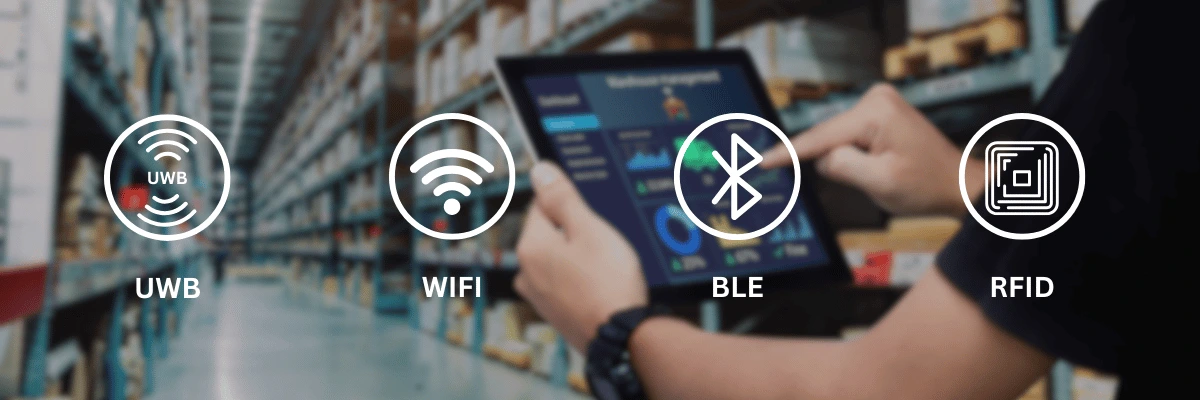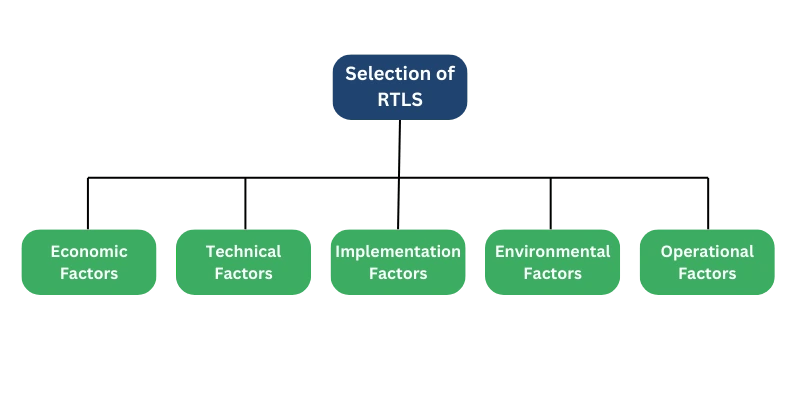
Selecting the right Real-Time Location System (RTLS) requires a thorough analysis of specific economic factors, technical factors, operational requirements and environmental factors. The initial step involves evaluating the existing manufacturing processes and facility environment.
One of the primary reasons for the underperformance of an RTLS solution is the lack of well-defined and realistic requirements. Precise communication of needs between the customer and vendor is essential. For example, specifying that a system must provide 10 cm accuracy may lead to unnecessary complexity and cost if the primary requirement is simply to identify the parking slot of each vehicle. Clearly defined requirements can prevent such issues.

Economic Factors:
Technical Factors:
Implementation Factors:
Environmental Factors:
Operational Factors:
It is crucial to collaborate with a vendor that understands industrial operations and can propose a tailored RTLS solution based on specific requirements.
The selection of the right RTLS technology requires a nuanced understanding of performance metrics: accuracy, range, scalability, power consumption, cost, and environmental adaptability.
RTLS can be implemented using various technologies based on an industry’s or organization’s specific use case. Since there’s no one-size-fits-all solution, the ideal technology depends also on factors like business needs, budget, and required flexibility.
This analysis compares Bluetooth Low Energy (BLE), Ultra-Wideband (UWB), Radio Frequency Identification (RFID), Wi-Fi, and hybrid systems.
Frequency Band: Operates in the 2.4 GHz band, commonly shared with WiFi and other wireless technologies.
Accuracy: BLE offers moderate location accuracy ranging within a few meters (from 1 to 5 meters), depending on the deployment (beacon density and algorithm sophistication). Angle-of-arrival (AoA) enhancements have improved accuracy to sub-meter levels in optimal conditions.
Transmission Range: Depending on obstacles and environmental conditions can reach up to 100 meters indoors, extendable with mesh networks, though signal stability decreases significantly with presence of obstacles.
Power Consumption: Low, making it ideal for battery-powered tags with lifespans exceeding several years.
Scalability: High, supported by widespread smartphone integration, advanced positioning algorithms, and mature IoT ecosystems.
Cost: Affordable hardware and deployment costs due to commodity hardware and broad vendor support.
Data Rate: Offers moderate data rates, reaching up to 2 Mbps.
Communication Method: Supports bidirectional communication for data exchange.
Environmental Factors: Susceptible to RF interference from Wi-Fi and other 2.4 GHz devices, affecting accuracy in dense environments.
Decision Insight: BLE is cost-effective and scalable for any indoor space operations where moderate accuracy suffices, such as in retail, smart offices, and general logistics.
Frequency Band: Operates over a wide range from 3.1 GHz to 10.6 GHz.
Accuracy: Exceptional, achieving 10-30 cm precision due to time-of-flight (ToF) and angle measurement capabilities. Ideal for applications requiring fine-grained tracking, like robotics and high-value asset management.
Transmission Range: 10-50 meters indoors, with high reliability even in multipath environments.
Power Consumption: Moderate for tags, higher than BLE, making battery life shorter, though advances in UWB chipsets (e.g., IEEE 802.15.4z) are improving efficiency.
Scalability: Limited compared to BLE due to infrastructure costs and the need for precise calibration.
Cost: Higher hardware and installation costs due to specialized anchors and tags.
Data Rate: Offers high data rates, up to 1 Gbps.
Communication Method: Uses bidirectional communication with short pulses for precise location tracking.
Environmental Factors: Superior performance in complex indoor environments due to resilience against RF interference and obstruction effects.
Decision Insight: UWB is the go-to for mission-critical applications where centimeter-level accuracy is non-negotiable, such as autonomous vehicles, industrial automation, and secure access control.
Frequency Band: Works across low (125–134 kHz), high (13.56 MHz), and ultra-high (860–956 MHz) frequency bands, depending on the application.
Accuracy: Passive RFID (such as anti-theft tags inside shops) offers room-level detection (up to 1-3 meters), while active RFID can reach 3-10 meters, but with less precision than BLE or UWB.
Transmission Range: Passive tags: a few centimeters to several meters depending on frequency (LF, HF, UHF); active tags: up to 100 meters.
Power Consumption: Passive tags require no battery, while active tags have moderate power needs.
Scalability: High for passive systems due to low tag costs. Active systems are less scalable due to higher maintenance and infrastructure costs.
Cost: Extremely low for passive tags, moderate for active RFID infrastructure.
Data Rate: Data rates differ by frequency, ranging from a few Kbps to tens of Kbps.
Communication Method: Typically unidirectional, transmitting data from tags to readers.
Environmental Factors: Metal and liquids can interfere with UHF signals.
Decision Insight: RFID excels in inventory management and supply chain tracking where cost efficiency outweighs the need for real-time, high-precision localization.
Frequency Band: Wi-Fi RTLS operates primarily in the 2.4 GHz and 5 GHz bands, similar to standard Wi-Fi networks. Some systems also support 6 GHz (Wi-Fi 6E) for enhanced performance.
Accuracy: 5-15 meters, improved with Time Difference of Arrival (TDoA) and advanced algorithms, but still less precise than BLE or UWB.
Transmission Range: Indoor range is typically 30-50 meters per access point (AP) due to walls and interference.
Power Consumption: High, unsuitable for battery-powered tags; often relies on devices with constant power supply (e.g., smartphones).
Scalability: Excellent in environments with pervasive Wi-Fi networks, reducing infrastructure costs.
Cost: Low when leveraging existing Wi-Fi infrastructure; however, retrofitting for accuracy can increase costs.
Data Rate: Data rates vary based on the Wi-Fi standard used:
Wi-Fi 4 (802.11n): Up to 600 Mbps is common in many RTLS
Wi-Fi 5 (802.11ac): Up to 3.5 Gbps for high-performance RTLS applications
Wi-Fi 6 (802.11ax): Up to 9.6 Gbps for emerging RTLS systems
Communication Method: Wi-Fi RTLS uses bidirectional communication. Tags or devices communicate with access points to determine location using methods such as RSSI, ToF, or AoA for more precise tracking.
Environmental Factors: Prone to signal fluctuation due to multipath effects, congestion, and interference in dense networks.
Decision Insight: Wi-Fi RTLS is advantageous for large facilities with existing Wi-Fi infrastructure, suitable for personnel or people tracking and non-critical asset monitoring such as in conferences.
Accuracy: Hybrid systems combine BLE, UWB, Wi-Fi, and even GPS for dynamic accuracy, optimized based on context (e.g., switching to UWB in high-precision zones).
Range: Flexible, leveraging the strengths of multiple technologies—long-range coverage via Wi-Fi/GPS and pinpoint accuracy via UWB/BLE indoors.
Power Consumption: Optimized through adaptive operation; devices can switch between low and high-power modes.
Scalability: High, but complex to implement due to system integration and interoperability challenges.
Cost: Higher upfront costs due to infrastructure and software complexity but balanced by operational flexibility and performance.
Environmental Factors: Adaptable to diverse environments by leveraging the most suitable technology per context.
Decision Insight: Hybrid systems are ideal for complex, large-scale operations like airports, hospitals, and smart cities, where both broad coverage and high accuracy are required.
When choosing the right Real-Time Location System (RTLS), it is crucial to match the technology with specific operational requirements. Consider these key points:
Accuracy Requirements:
Cost Efficiency:
Tag Cost:
Scalability and Integration:
Environmental and Operational Factors:
Since these priorities may conflict, a detailed evaluation is essential. Consulting with RTLS experts helps balance these factors and select a solution aligned with current and future needs.
📍 We’re expanding our horizons! Stay tuned for upcoming product and service launches.📍
©2024 anyRTLS, All rights reserved.